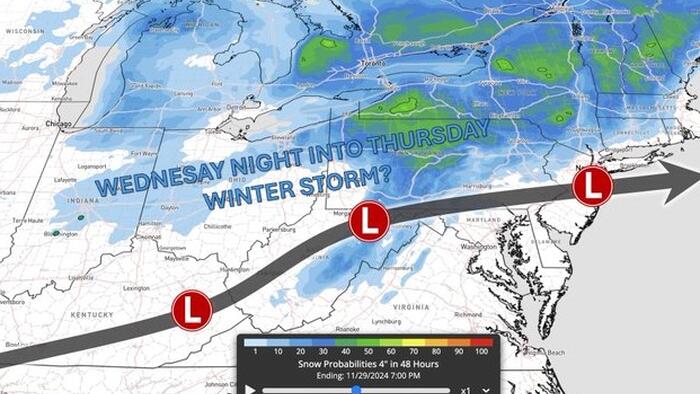As residents of the Mid-Atlantic and Northeast continue to recover from a recent snow and rainstorm, meteorologists are warning of another potential winter storm that could impact travel along the Interstate 95 corridor, particularly between Washington, DC, and New York City, right before the Thanksgiving holiday. Private weather forecasting agency BAMWX has reported that over 100 blended weather model ensembles are indicating the possibility of a winter storm moving through the region during the holiday period. Current forecasts predict a risk of accumulating snow—at least four inches—on the days leading into and following Thanksgiving, specifically from Wednesday into Thursday. This data is derived from BAMWX’s Clarity platform, which synthesizes multiple weather models to create probability maps that assess potential threats to the area.
Meteorologist Cody Braud from FOX Weather corroborated the forecasts, stating that while the specifics of the storm’s timing are still uncertain, “there is 100% going to be a system knocking on our door.” He suggested that travelers should prepare for significant disruptions, especially on Friday, when strong winds and precipitation—including rain and potentially snow—are expected due to a low-pressure system likely forming offshore. This potential adverse weather has raised concerns among travelers, as Thanksgiving typically marks one of the busiest travel periods in the United States.
The upcoming storm is particularly consequential given AAA’s prediction that 79.9 million people will travel at least 50 miles during the Thanksgiving travel period. This figure underscores the scale of mobility expected as families and friends gather for the holiday. Stacey Barber, a Vice President at AAA Travel, remarked that this year may break previous records for various travel modes, including by car, plane, and cruise. The convergence of heavy travel schedules and adverse weather conditions could result in significant disruptions, necessitating careful planning for those intending to travel during this time.
In addition to travel concerns, the potential for winter weather is feeding into broader economic discussions. Natural gas prices have recently surged to their highest levels in a year, attributed to forecasts detailing a notably cold pattern developing across much of the continental United States. Analysts emphasize that the weather trends could influence energy costs, particularly as the demand for heating rises with colder temperatures. This price increase is indicative of the link between seasonal weather patterns and market dynamics, impacting both consumers and suppliers in the energy sector.
The winter storm threats have also captured the attention of weather enthusiasts and professionals across the industry. Comments on various social media platforms highlight a general buzz regarding the forecasts, with some referencing the “Trans-Siberian Express,” a metaphor indicating a significant wave of cold air that may sweep across the eastern United States following Thanksgiving. While there has been little winter weather observed in the region recently, these predictions suggest a shift toward early winter conditions, a potential precursor to more severe winter weather in December.
As the Thanksgiving travel date approaches, the combination of projected hazardous weather and record travel numbers emphasizes the importance of monitoring evolving weather forecasts. Both AAA and meteorologists advise that travelers stay updated to avoid disruptions during one of the busiest and most celebrated holidays of the year. With winter weather seemingly poised to affect millions, both the travel industry and everyday travelers must remain vigilant as the holiday draws nearer.

